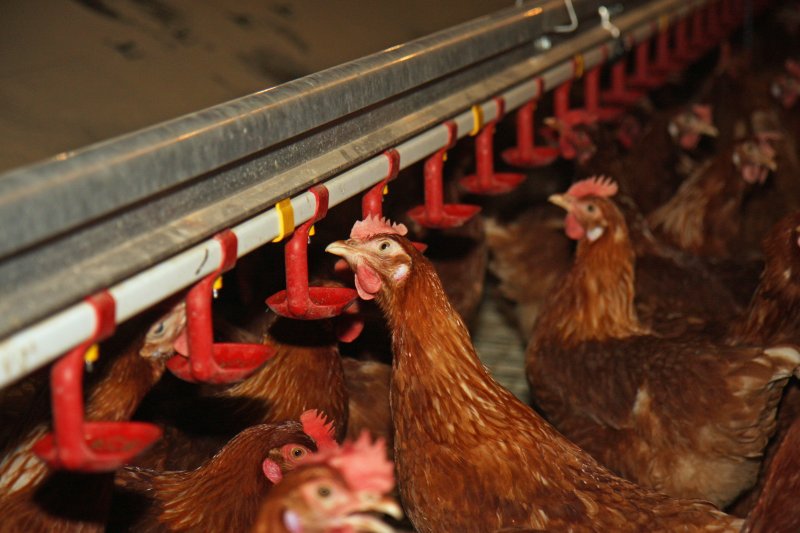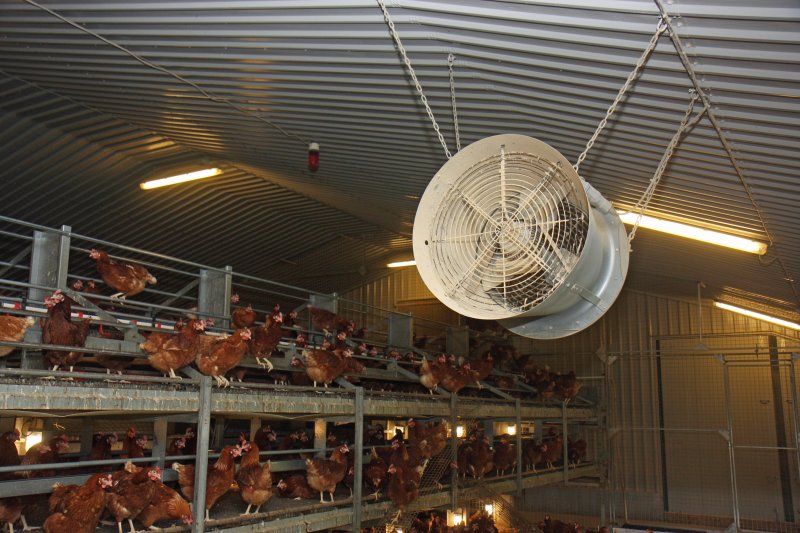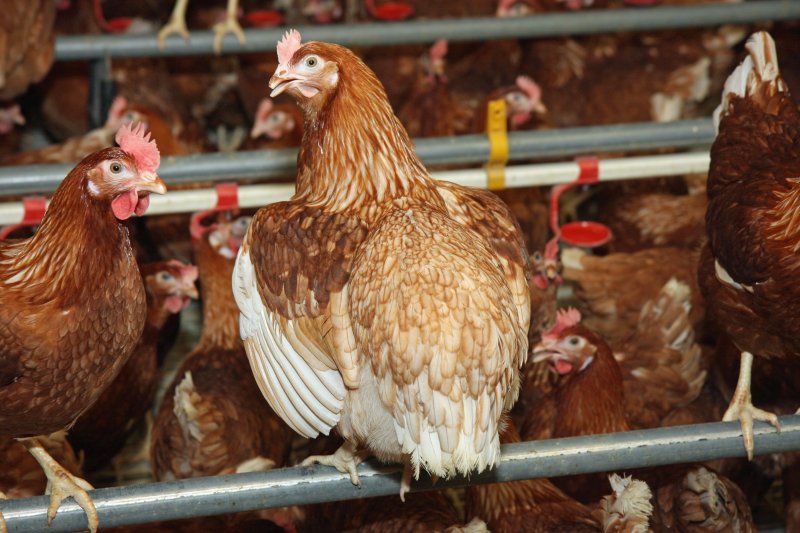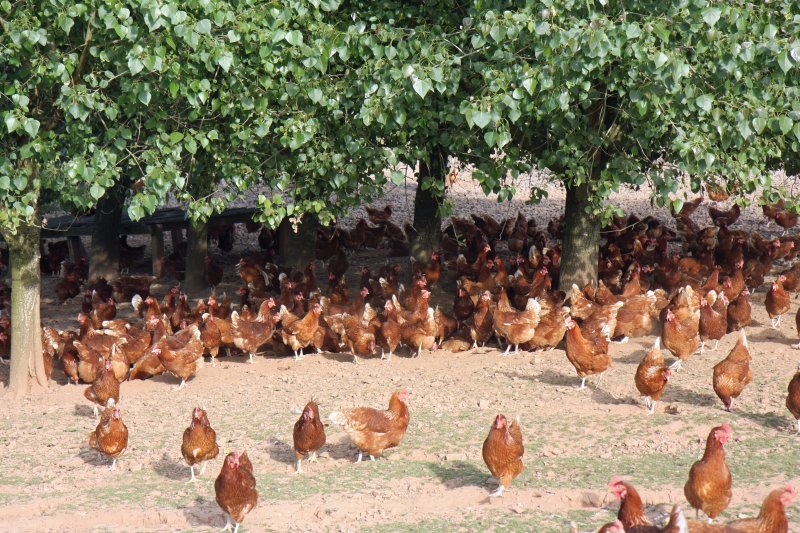
A webinar hosted by poultry firm Hy-Line last month was timed perfectly with the focus on heat stress coming days before the UK entered another period of record hot weather.
Dr Ian Rubinoff, Hy-Line International’s Director of Technical Services, told the audience that heat stress in chickens was a combination of temperature and relative humidity (RH).
The higher the RH then the lower the temperature needs to be before a heat stress situation is reached.
“A temperature as low as 22°C with a RH of 75 per cent can be considered an ‘alert’ situation, whilst the ‘danger’ threshold might be 34°C at low humidity or 26°C with high humidity,” explained Dr Rubinoff.
“A chicken’s normal body temperature is 41-42°C and for them to stay within this range they have to balance the metabolic heat produced by their body with normal heat loss but this heat loss becomes more difficult when environmental temperatures are high.
“The bird’s physiological response to heat stress will impact on shell quality, on the immune system and potentially cause mortality if the heat gets bad enough.
"Because chickens don’t sweat they pant to cool down, increasing their respiratory rate which can lead to alkalosis due to reduced carbon dioxide (CO2) in the bloodstream.
"It is this reduction in CO2 in the blood stream that is primarily the challenge for egg quality. Together with other physiological responses, such as increased heart rate, pancreatic activity and kidney response, it can lead to drops in production and mortality if not mitigated by ventilation and management,” warned Dr Rubinoff.
He went on to explain how birds thermoregulate: “They spread their wings to increase airflow to the blood vessels that are close to the skin under the wings and they will pant to try and cool by evaporation.
"They will also increase the blood flow to external parts of the body such as the comb and wattles and may seek cooler parts of the house such as the floor if housed in an aviary-type system.”
Dr Rubinoff explained further the relationship between heat stress and shell quality. “When the birds are panting they lose CO2 to the air from the bloodstream. CO2 is a critical component of carbonic acid in the blood.
"It is crucial to the creation of calcium carbonate which the hen uses to make the shell. As CO2 is lost, carbonic acid in the blood is reduced.
"We also have to deal with the fact that the hens will be eating less and will not have as much calcium in their digestive tract. This combination will lead to less calcium being available to make a strong shell.”
Dr Greg Celliers, Hy-Line’s Global Veterinarian for the region, went on to outline some of the interventions that could be employed when things start to hot-up in the poultry house.
“Behaviour is an indication of bird comfort, wing spreading, panting, slow and lethargic, and eventually stupor, staggering and convulsions,” said Dr Celliers.

“When this type of behaviour is first observed the priority should be to increase ventilation. Check and adjust the setpoint temperature if required – airflow at bird height is key to removing heat.
"This can be difficult to achieve in aviaries or cages as the system offers interference to airflow. No unnecessary obstructions should be in the house which will further obstruct air flow.
"Dust and cobwebs at air inlets and outlets will restrict airflow and should be removed.”
Dr Celliers explained that evaporative cooling could be used as a means of reducing temperature within the house, either by cool pads or fogging, but could only be used when RH was below 75% as evaporation uses heat from the air to vapourise water which lowers the temperature but at the same time increases humidity.
It is important to make sure that birds are evenly distributed through the house as not only does stocking density affect the birds’ ability to keep cool but access to feed and water should be evenly distributed.
“A bird’s water to feed intake is normally 2:1 at around 21°C but at 38°C this increases to 8:1,” said Dr Celliers. “So drinking water must be available to heat stressed birds in the amount they require.
"To achieve this your drinkers must have sufficient water flow – for nipples that’s 70 ml/minute. Access to drinkers is important both in space and in height and for floor reared birds additional drinkers can be provided.
"Blocked filters will restrict flow so check them and change them if necessary and cooler water will reduce birds’ core temperature.
"Birds prefer to drink water below 25°C and above 30°C they’ll refuse to drink so flush lines regularly, particularly in the afternoon. Insulation or shade for water pipes and tanks will help keep water cool.
“I had a client in Botswana who would freeze buckets of water containing stress packs and then place in the header tanks during periods of hot weather.
"This cooled the water whilst at the same time getting the stress pack into the birds. Talking about stress packs,” siad Dr Celliers, “you can add electrolytes and vitamins to water because heat stress causes the loss of several minerals including potassium, sodium, magnesium and zinc.
"Potassium chloride electrolytes seem to increase water intake when supplied at 0.6 per cent and vitamin C will help reduce egg production drops and poor shell quality.
"Ideally they should be administered prior to a heat stress period so monitoring weather forecasts is important.”
When it comes to feed, it’s well established that intakes will be depressed in periods of heat stress and Dr Celliers advice was to adjust the nutrient density accordingly.
“The energy intake should not be increased as this could further depress intake and reduce further the intake of other key nutrients. Try to minimise excess protein in the diet as excess nitrogen intake places an additional metabolic burden on an already stressed bird.

"Metabolic heat production from digestion is real so why feed birds over midday? Aim to feed in the morning, allow them to clear up the troughs over midday then feed again in late afternoon.”
As for feed additives, potassium chloride, ammonium chloride or sodium bicarbonate can replace electrolytes lost through heat stress, advised Dr Celliers.
“Phytogenic additives are becoming more and more popular in diets. They exert an anti-inflammatory and even an anti-oxidant effect in the birds which aid in stabilising the gut.
“Birds can be picky eaters and one way round this is to pellet the diet. The trick is ensuring the pellet is the correct size, four to five millimetres is ideal.
"Wetting feed is another trick to increase feed intake but should be managed so as not to leave wet feed in the troughs. Run feeders more frequently.
"It may mean you have to manage hopper levels carefully to avoid wastage but the sound of the feeder running will encourage birds to investigate.
“Don’t reduce litter depth, stay with 5cm. This is going to be needed to absorb increased water expulsion by the birds and absorb any water spillages during hot weather.
"Roof insulation is the best way to reduce heat radiation,” continued Dr Celliers, “and consider things like painting the outside a colour that reflects heat.
"Sprinklers can be placed to spray water on the outside of the roof which will also remove heat, as will circulating fans if placed correctly in the house. The focus on ventilation shouldn’t just be in the day.
"Ventilate at night and adjust thermostats so fans run fully at night and early morning. The goal being to maximise night time cooling to prolong moderate temperatures the following day.”
Throwing further light on air movement was former ADAS poultry ventilation expert Justin Emery, now Senior Ventilation Consultant for DraperVent.
“Looking back at weather records, certainly since 2010, there hasn’t been a year where temperatures have failed to exceed 30°C and we need to be aware of this when designing and managing poultry houses,” said Mr Emery, going on to explain just how much heat a house full of layers can produce.
“We know from previous research that a hen’s heat output is around 6.5 to 7.0 Watts per kilo of bodyweight so that’s around 160 – 180 kW of ‘sensible heat’ that needs to be removed from a 16,000-bird house. Sensible heat is essentially heat that can be recorded by a thermometer.”

Earlier work by ADAS has established a heat balance equation which is used to arrive at a recommended maximum ventilation rate figure of approximately 9 – 10 cubic metres per hour per hen.
“The simple rule should be 10 cubic metres per bird but the industry tends to be lower than that,” said Mr Emery, explaining that the aim was to restrict any lift in temperature inside the house to within three degrees of outside temperature.
“If it’s 25°C outside the aim is to restrict it to no more than 28°C inside. A lot of ventilation systems struggle to achieve this and where theoretical calculations are based on restricting the lift to 5°C, it’s not enough to generate sufficient airspeed and air change.
" On the other hand, to restrict lift to below 3°C would mean spending a disproportionate amount of money on fans.
“The bottom line is we should be designing houses to be relevant for as long as possible. So anyone designing a new house should be looking seriously at hot weather ventilation and know how to get that air movement and air change through the house.”
Mr Emery went on to make a comparison between the layer and broiler sectors. “In the broiler industry, houses tend to be defined by the ventilation system but in the egg laying sector producers tend to talk about the nest system and often don’t know the specification of the ventilation system.
"I’ve been into valleys in Wales where there has been exactly the same nest system on farms side by side but three different ventilation systems.
"When you ask why is that the case, the short answer is they don’t know. What is essential is that the house needs to do a winter ventilation system as well as a good summer ventilation system and sometimes we don’t get both.”
Mr Emery’s presentation included a detailed explanation of the different types of ventilation system commonly found in layer houses including that designed by Draper Vent, a system that gives full recirculation of air in the winter using the full 160 kW of heat produced by the birds.
This air is rotated around the house almost as fast as it would in a heat stress situation in the summer and in doing so, has a drying effect on the litter.
The full webinar can be viewed in the ‘News’ section at www.hyline.co.uk
